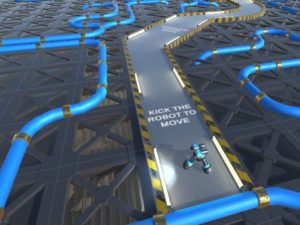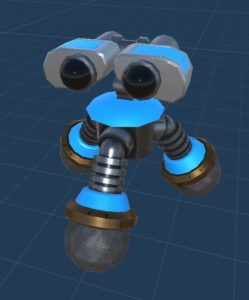
This was to be the first in a LUMOplay-exclusive series of games branded as “Xenobot” games. Hammy was one such Xenobot, and was one of only two to get an actual game before the series was shelved in favor of other ventures.
The game itself is a floor-based experience, wherein a player must “kick” Hammy around a maze-like level (think similar to classic Pacman games) searching for missing parts that act as keys to the end-of-level teleporter gate.
There’s no way to properly die in the game, as the controls aren’t quite precise enough to give the player full agency over Hammy’s movements, and player-death was quickly deemed too frustrating to be a viable mechanic. Instead, players play against a timer, trying to finish as many levels as possible before time runs out.
The ‘bot
Hammy is the first Xenobot, and the only one to receive his own named game. He was developed concurrently with the maze-based gameplay itself, and this influenced his design considerably.
Right off the bat, Hammy is so named because his original incarnation -a rolling ball remarkably similar to Star Wars’s BB-8- was essentially a rolling hamster-ball. Hence, “Hammy.” However, that design proved u ntenable, as it was too difficult to make the character emote in a way that was easily observable from above or from any meaningful distance.
ntenable, as it was too difficult to make the character emote in a way that was easily observable from above or from any meaningful distance.
After a few iterations of rolling-ball transforming designs -such as a vaguely spider-like machine that rolled into a ball, and a mechanical armadillo- Hammy became a kind of rolling tripod, with a pair of emotive, binocular-like eyes on an articulated stock. This design meant that Hammy wouldn’t be able to interact with anything directly, as he lacks manipulator digits, but it was suitably emotive, and it was decided that making Hammy more specialized lent itself well to the “team” concept that was at the time the plan for the Xenobots
The Maze
Built out of a series of simple square tiles, the eponymous maze is stylized as a manufactory, with plenty of exposed metal and striped yellow-and-black caution lines. Nonetheless, every effort was made to keep the levels bright and friendly. Child-friendly, after the goal of the Xenobots series as a whole.
Whenever possible, the exposed metals are bright and shining. Not new, per se, but clean and well-kept. Whenever possible, paints and plastics are bright primary colors, made to catch the eye. The entirety of the level is kept brightly-lit to avoid long dark shadows commonly associated with typical factories, using both baked and real-time lights.
Alongside the levels themselves are the goals of the whole thing; the escape teleporters. At the end of the day, the teleporter is just another tile, but it holds several features the other tiles don’t. Animation, for one. When the player has collected all of the missing parts spread throughout a level and returned to the teleporter, it activates. Pillars rise from their covered slots in the floor and arc electricity as the teleporter activates and transitions to the next level. That electricity is the other special feature; particle effects. When the teleporter is activated, it essentially floods the entire game area with particles until the screen is a solid color. This serves the dual purpose of visually representing the teleportation, and allowing the transition between scenes necessary when switching levels.